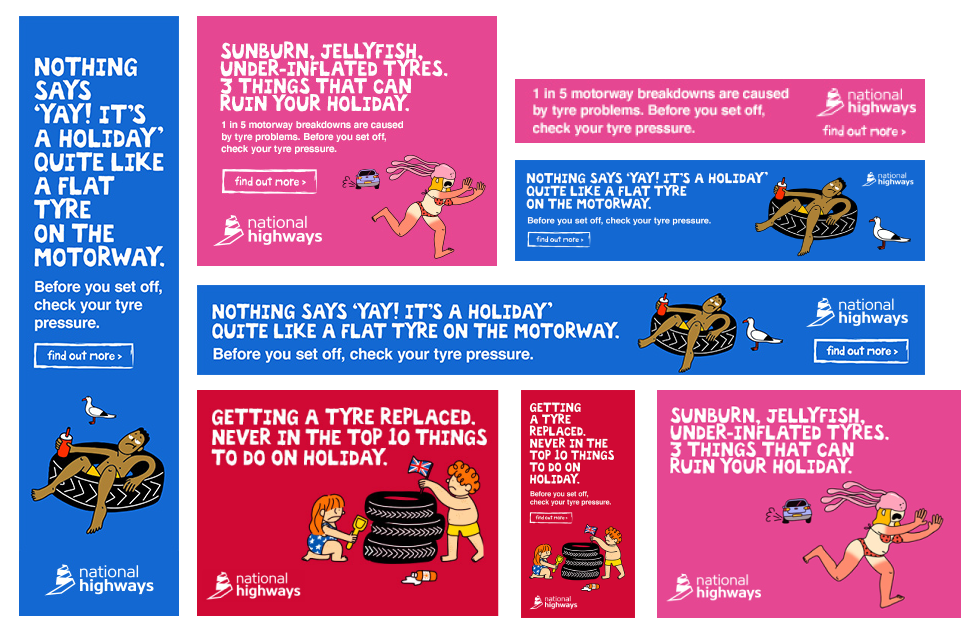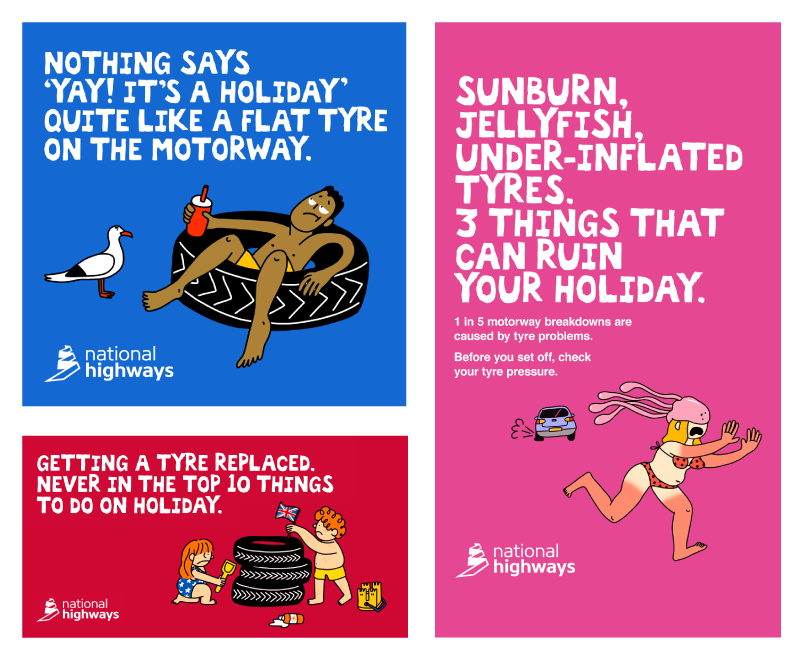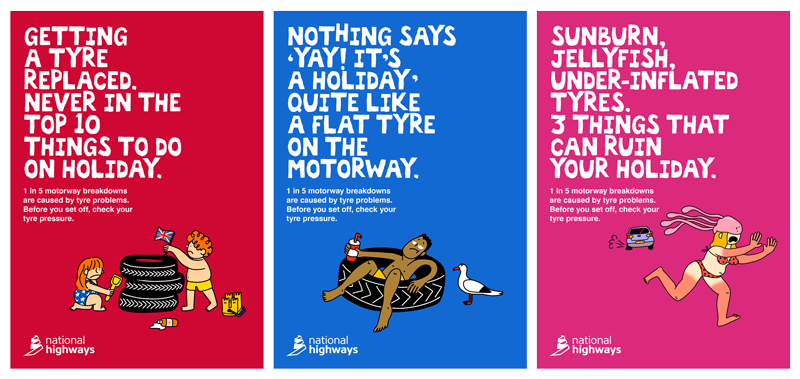Background and campaign objective
Safety is our number one priority – any death on our roads is one too many. While our roads are among the safest in the world, we recognise there is always an opportunity to make journeys safer, easier and more reliable for users.
The 2022 Summer Tyre Checks campaign is one of the two central pillars of our summer marketing activity. Running for over three weeks, this national campaign aims to move people from awareness of the need to maintain correct tyre pressure to action, reminding and motivating more road users to check their tyres before a long journey, with a secondary objective to carry out further checks. The campaign will contribute to a reduction in the number of breakdowns and road incidents caused by tyre problems.
Our summer tyre checks campaign goes live on Wednesday 6 July and runs for over three weeks until Sunday 31 July.
We've also produced a campaign toolkit which can be used as a menu to all of the content featured on this page.
If you do support the campaign, we'd love to hear about it for our evaluation – please email: marketing@nationalhighways.co.uk.
Key messages
Primary message
1 in 5 motorway breakdowns are caused by tyre problems. You’re more likely to be involved in a breakdown if your tyres are incorrectly inflated. Make sure you check your tyre pressure before you go on a day trip or holiday this summer.
Secondary messages
- Driving with under-inflated tyres – even as little as 10 per cent below – makes your braking distance longer, your vehicle harder to steer, uses more fuel more quickly, and shortens the lifespan of your tyres, forcing earlier and more frequent replacement.
- Driving with low-tread tyres reduces the control you have over your vehicle, makes your braking distance longer and costs you more in fuel.
- Legally, your tyres should have a tread of at least 1.6mm. If you’re stopped by the police and found with illegal tyres, you could receive a £2,500 fine and three penalty points per tyre.
- Poor tyre pressure and over-worn tyres cause crashes and breakdowns on the strategic road network (motorways and major A roads).
- With most Covid-19 restrictions withdrawn in March 2022, families are looking forward to getting back to day trips and holidays this summer. With most cars driven considerably less over the last two years and the impact of the cost-of-living crisis, vehicle checks are more important than ever.
- Anyone taking a long or significant journey should check their vehicle before setting off, including tyre pressure, tyre tread, fuel, oil, screenwash and lights.
- For any significant or long journey, always check your tyre pressure is in line with your make and model’s recommendations – found in your vehicle’s manual, petrol cap or driver door – and that tyre tread is more than 1.6mm.
- It takes around 10 minutes to check tyre pressure and tread before setting off on a long journey – don’t risk ruining a long-awaited day trip or holiday with a breakdown or incident caused by poorly maintained tyres.
- 1 in 5 motorway breakdowns are caused by tyre problems.
- In 2019, almost half of accidents on the SRN in which vehicle defects were a contributory factor were due to underinflated, defective or illegal tyres.
- One in five adults, and three in five young people, admit to never having checked their tyre tread depth (Tyre Safe).
- 2.2 million, or 7% of MOT failures in the UK during 2018 to 2019 were given due to tyre failures.
- A third of drivers (31%) are not confident checking tyre pressure according to recent National Highways research.
- Female drivers tend to be less confident than male drivers when it comes to checking tyre pressure, with 57% admitting to getting somebody else to do it for them.
- Despite the Highway Code stating that tyres must always be correctly inflated and free from defects, only 17% of drivers check tyre pressure before long journeys.
- Driving with underinflated or overinflated tyres can make your braking distance longer, make it harder to steer, reducing fuel efficiency and shortening the lifespan of your tyres.
- To check your tyre pressure, visit most fuel and service station forecourts, which have an air machine for checking and inflating your tyres.
- Each vehicle make and model has a different recommended tyre pressure for different driving conditions – you may need higher air pressure in your tyres if you’re carrying lots of passenger and luggage. These can usually find this on the inside of the driver’s door, petrol cap, in your vehicle manual, or online.
- To check your tyres, set the air machine to the recommended tyre pressure, unscrew the valve caps on each of your tyres and firmly attach the air pressure gauge to the tyre valve – you should hear a little ‘hiss’ as it connects – and the machine will now give you a reading. If the reading is lower than the recommended pressure, the machine will inflate your tyre to match. If the reading is higher, then you need to let some air out – most machines do this automatically.
More information
More supporting information can be found on the campaign website.
You can find more information about what to do in the event of a breakdown on our breakdowns page. You can find all of our road safety information in our Road safety section.
Content section
The campaign offers a range of assets for partners to use, including:
- Campaign narrative that can be used for creation of web content, blogs, newsletter
for your audience to read, or any internal comms to your colleagues or members. - Posters, to be used at OOH placements as well as in-store or any indoor area where
your audience might see them. - Digital and social assets (including static posts as well as animated gifs), to be used
on your social media channels, websites or any other digital channels, e.g. digital screens.
Download the toolkit
Download the narrative
Digital assets
Web banner creative files including
Mailchimp banner with
Tyre Pressure creative:

A4 posters
- A4 summer tyre checks 'jellyfish' poster.pdf
- A4 summer tyre checks 'rubber ring' poster.pdf
- A4 summer tyre checks 'sandcastle' poster.pdf
- Whole suite of posters


